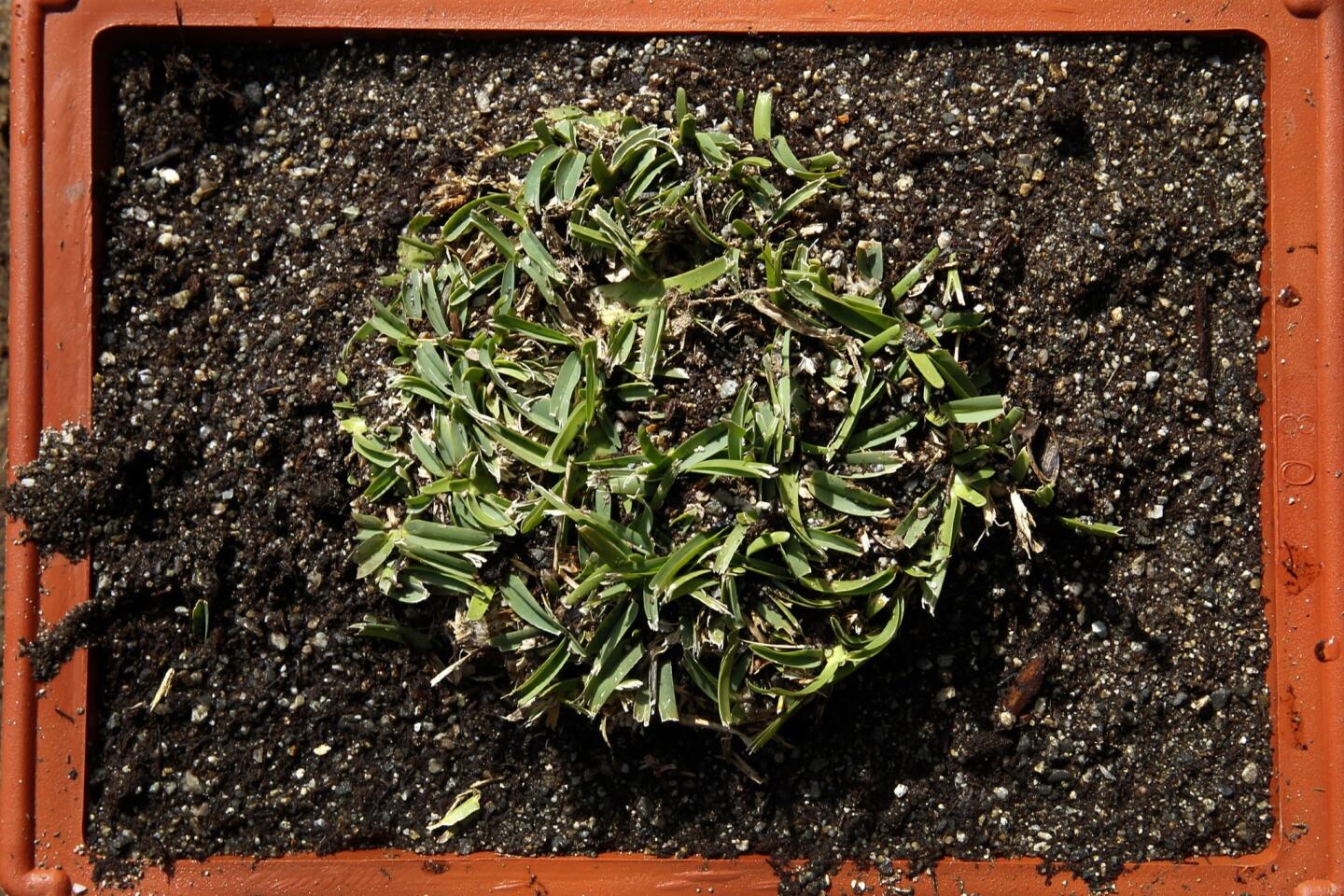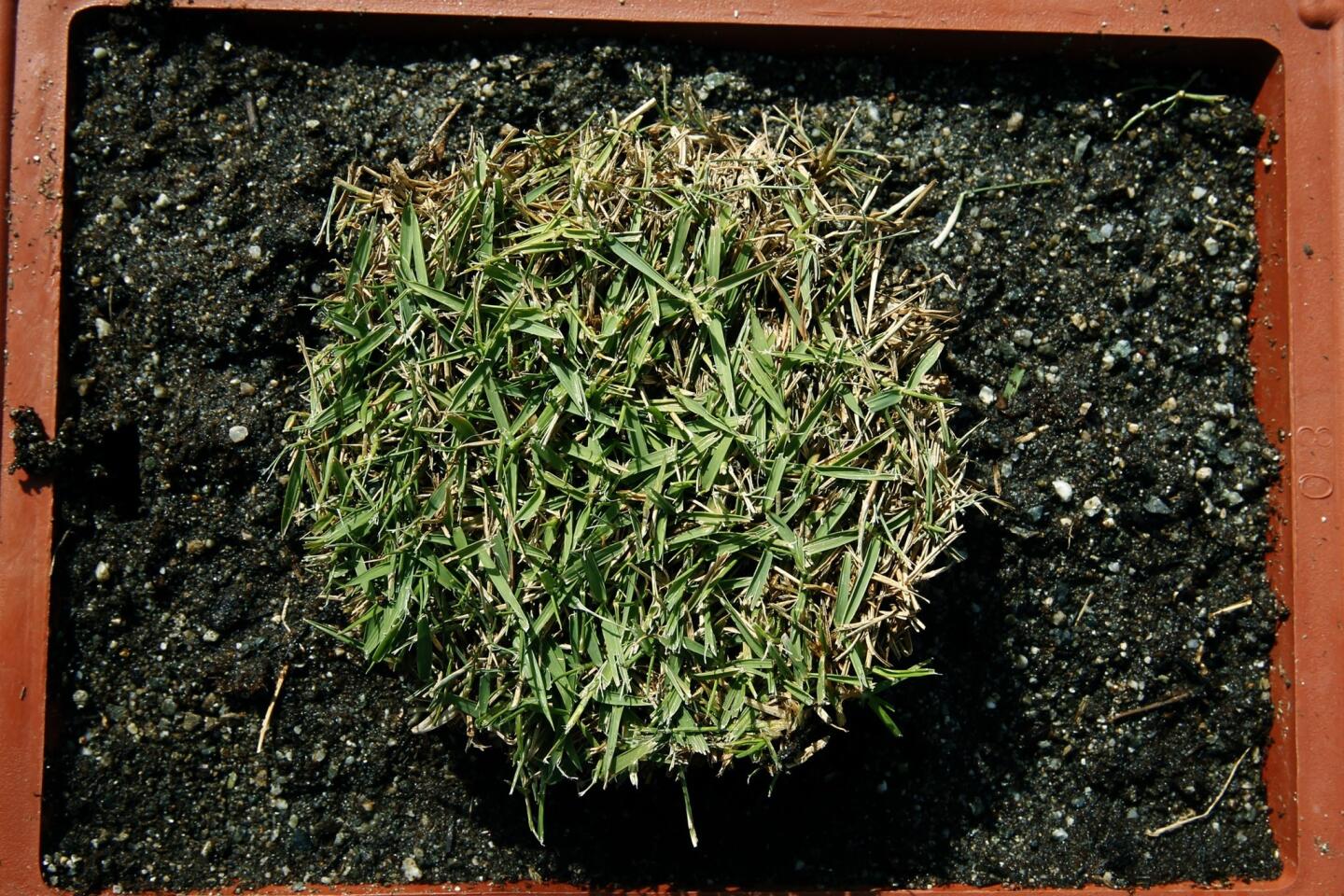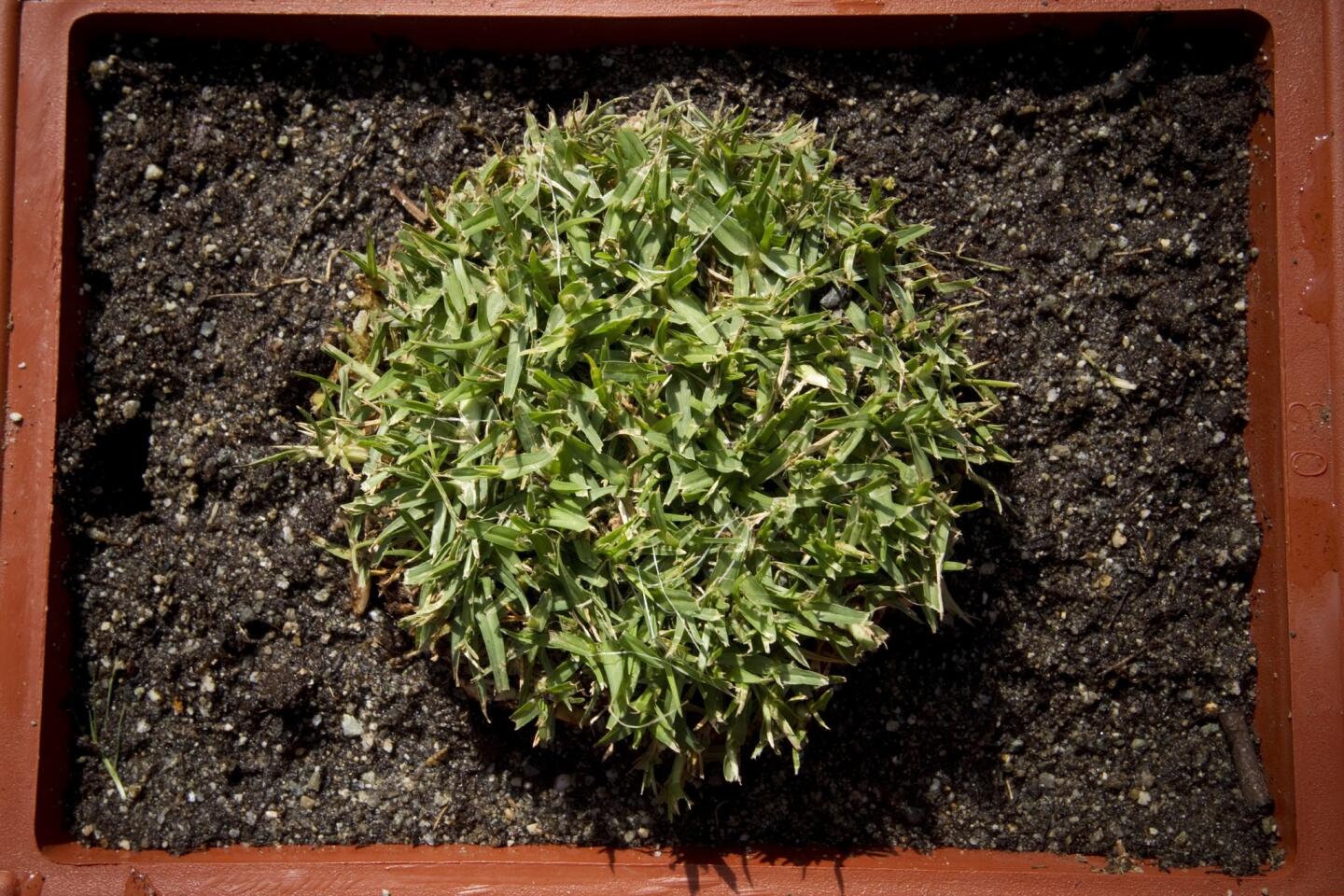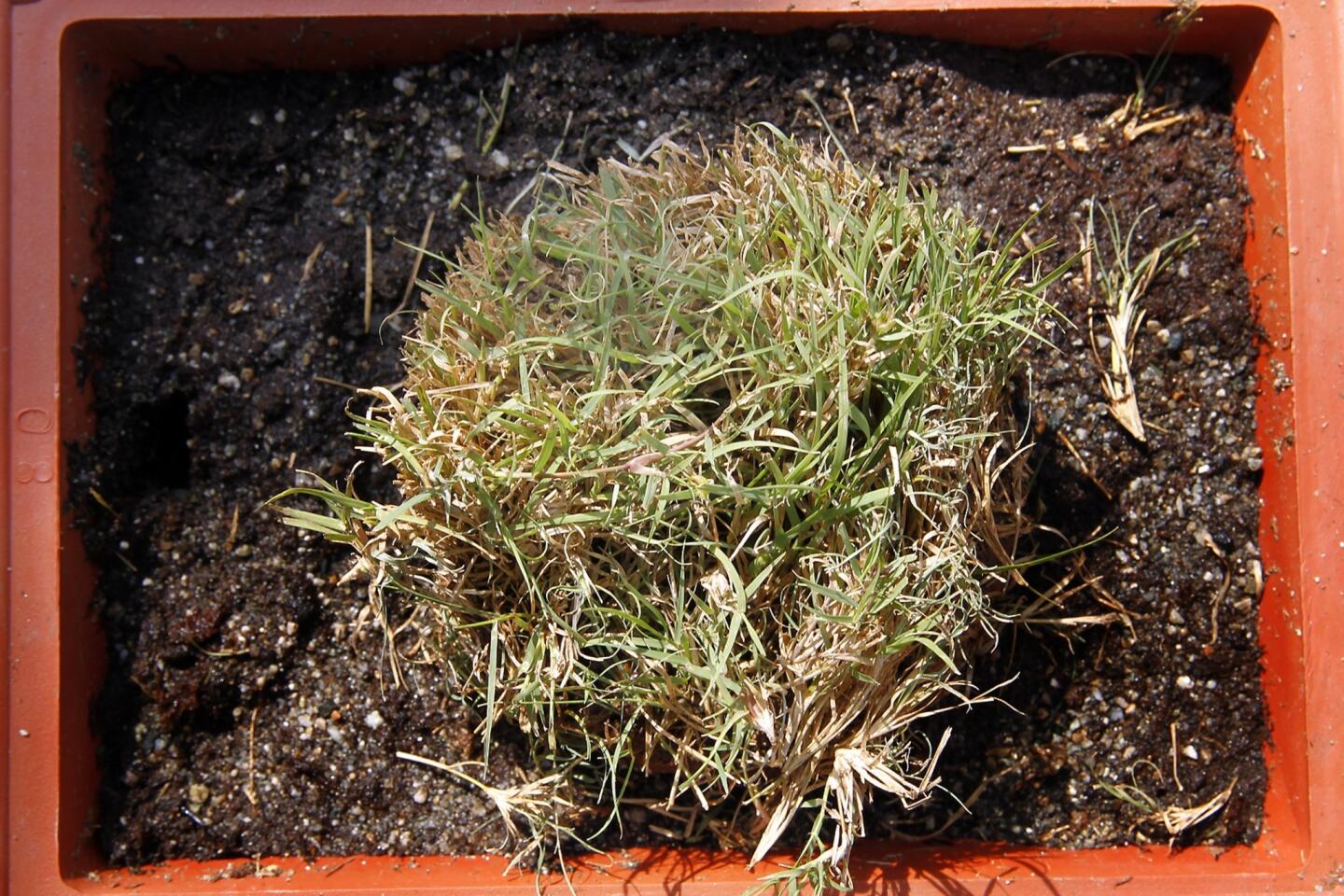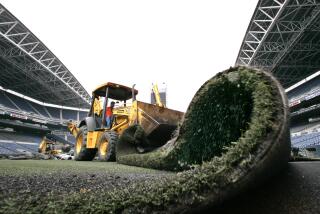Drawing a line on the lawn amid water conservation and drought
- Share via
“This is the irony,” mused homeowner Richard Turner as he looked over the newly installed and remarkably realistic-looking artificial lawn in his mid-Wilshire frontyard. “We grow grass to make the illusion that we don’t live in a desert. Here I am, enhancing the illusion of a lawn that is the illusion we don’t live in a desert.”
And there’s the rub. The iconic lush, green lawn — part and parcel of a mystique deeply embedded in the Southern California psyche and its landscape — has reached a crossroads. Deepening drought, skyrocketing water costs and burgeoning social consciousness have combined to call into question not only the lawn’s continued feasibility but its very desirability.
The issue is polarizing, often passionate, with science fueling both sides of the argument. Turf supporters contend lawns not only cool the surrounding air and generate oxygen but also pull harmful carbon dioxide out of the atmosphere. Opponents counter that any such benefit is more than offset by the lawn’s sizable carbon footprint, from the cost to water it to production and transportation of fertilizer to feed it and gasoline to mow it.
PHOTOS: Warm-season grasses for drought conditions
The perception of the home lawn as a guilty pleasure is growing. Many municipal water districts, including the Los Angeles Department of Water and Power, the Long Beach Water Department and Pasadena Water and Power, offer “cash for turf” programs, rebates of $1 to $3 a square foot to replace a grass lawn with low-water plantings. The LADWP, which has had a program in place since 2009, reports a tenfold increase in its turf removal projects since last summer. Increasingly, homeowners — sometimes with ambivalence — are replacing lawns with mixes of native plants, decomposed granite and succulents.
“The days of everyone expecting to have a lush green lawn are over,” said Glendale homeowner Tamara O’Connor, who, after 27 years, is pulling out her large front lawn. “Everything is changing, isn’t it?”
For some, the time hasn’t come fast enough. Hadley and Peter Arnold, co-founders of the Burbank-based Arid Lands Institute, a think tank exploring design innovation in water-stressed environments, see the reevaluation of lawns as long overdue. The big issue, the Arnolds said, is the enormous energy cost of importing water into Southern California, 60% of which goes to irrigating landscaping, primarily lawns.
The Arnolds said they happily live without a lawn at their own home.
“We have an amazing yard — we eat in it, we play in it, our kids give performances in it, and there’s not a blade of Kentucky bluegrass on it,” Hadley Arnold said. “The lawn is a visual reference to other places and other times that we carry along like a security blanket that we don’t need.”
VIDEO: UC Riverside’s Jim Baird talks turfgrass and lawn care
Turfgrass suppliers, however, say not so fast. “You are not going to see lawns go anywhere in the near future,” said John Marman, director of sales and marketing for West Coast Turf, the largest turfgrass supplier in the Western United States. “It’s pretty amazing how important lawns are to people.”
Chantal D’Apuzzo, a new mother with a newly remodeled, midcentury ridge-top house west of the Rose Bowl, would agree. The D’Apuzzos, who have succulents elsewhere, are putting in a 40-by-40-foot lawn. “I have visions of my daughter taking her first steps and tumbling down on a lawn,” she said. “I imagine playing out there with her a lot. I don’t really feel guilty about it.”
The D’Apuzzos apparently are not alone. The LADWP is pleased with the recent rise in turf-rebate requests — 7.4 million square feet of turf have been removed from the Los Angeles landscape since 2009. But that is only 1,298 projects out of 482,000 single-family homes.
Marman of West Coast Turf reported that his business has increased during the drought as “a significant number are calling to replace their cool-season lawns with warm-season” grasses.
UC Riverside’s Jim Baird, assistant Cooperative Extension specialist in turfgrass management — the “last man standing” in California turfgrass research — believes that the biggest problem with the region’s lawns is people’s lack of understanding of how to manage them.
It starts with the choice of grass. The trend has been toward cool-season grasses — tall fescues such as Marathon — that stay greener longer but need more water. Warm-season grasses, often hybrids of Bermudas and buffalo grass, need 20% less water, and can survive with less. Their downside is that they can turn brown in winter — and Californians don’t like brown lawns.
Baird pointed out that grass goes dormant — and nearly ceases growing — in cold weather and needs little or no water, and no mowing. “My irrigation goes off and stays off during the winter,” he said.
In the hot summer months, Baird said, lawns need to be watered no more than three days a week. And watering should be done in a way that ensures penetration and minimizes runoff. He recommends one to four minutes at a time, three or four times each watering day. And always in the early morning or the evening, never in the heat of the day.
People also cut lawns too short at the expense of the root system. Deeper roots yield more drought tolerance.
“Managing your lawn is not rocket science,” Baird said. “There’s a lot of good information out there. You just have to want to find it.”
The key, said landscape designer Sasha Tarnopolsky of Dry Design, is to “be thoughtful. Only put a lawn where it will be used. You can think of it as a rug defining a room. Today’s purposeful lawns can be thought of as special and useful places, not wallpaper plastered over hill and dale.”
ALSO:
2014 spring garden tours scheduled for April and May
Lite + Cycle Urban Forest candles inspired by L.A.’s Griffith Park
Herman Miller brings back classic Eames chair in recyclable fiberglass
JOIN THE CONVERSATION: @latimeshome | pinterest.com/latimeshome | facebook.com/latimeshome | facebook.com/latimesgarden



